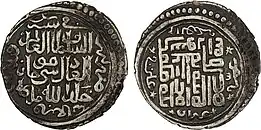| Musa | |
|---|---|
| Il-Khan | |
| Reign | 29 April 1336 – 24 July 1336 |
| Predecessor | Arpa Ke'un |
| Successor | Muhammad Khan |
| Vizier | Jamal ad-Din Hajji |
| Died | 10 July 1337 |
| House | Borjigin |
| Father | Ali (son of Baydu) |
Reign
He was a grandson of Baydu. After securing Shaykh Hasan's neutrality, Musa's patron Ali Padshah went on to battle Arpa Ke'un on Jaghatu plains near Maragha on 29 April 1336. Arpa's army were led by 60 emirs, notably Hajji Taghay (son of Sutai, Governor of Diyar Bakr, from Oirats), Uyghur commander Ögrünch, Torut (a son of Nari and relative of Narin Taghay), Ortuq-Shah (son of Alghu) and Chupan's son Sorgan Sira. However, soon some emirs defected to the side of Ali Padshah, such as Mahmud b. Essen Qutlugh and Sultanshah Nikruz. Battle was a defeat for Arpa and soon after he was captured in Sultaniya and killed.[1]

Subsequently, Musa was enthroned as new Ilkhan, in fact as a puppet of Ali Padshah. Supporters of Arpa Ke'un, namely Hajji Taghai meanwhile went to Jalayirid Hasan Buzurg, who in turn raised another Borjigid prince, Pir Husain as an Ilkhan on 20 July 1336. Chupanid Sorgan Sira again changed sides and joined Jalayirids at the battle of Qara Darra near Van. A Georgian contingent under Amirgambar I Panaskerteli, Duke of Tao also joined the battle on Jalayirid side.[2] Despite Ali Padshah's contingents defeating Hajji Taghay and Ögrünch defeating Surghan, Musa was standing on center and badly defeated. As a consequence, battle was lost and Ali Padshah was captured and executed while Musa was forced to flee on July 24, 1336.[3]
Despite losing his patron, Musa didn't relinquish his claim to Ilkhanate and retreated to Baghdad, later joining forces with Togha Temür in June 1337 occupied Soltaniyeh. However, he was soon captured by Emir Qara Hasan and killed on 10 July 1337.[4]
References
- ↑ "ARPA KHAN – Encyclopaedia Iranica". www.iranicaonline.org. Retrieved 2020-03-31.
- ↑ Jojua, Teimuraz (2015). "ეფრემ მცირის ჰომილეტიკური კრებულის (S-1276ა) 1370-1390-იანი წლების მინაწერის ცნობები მონღოლ სარდლებს – ულუსის ამირა შეიხ ჰასან ბოზორგსა და ამირა ალი ფადიშაჰს შორის 1336 წელს გამართულ ყარა დარას ბრძოლაში ტაოს ერისთავის, ამირღამბარ I ფანასკერტელის ვასალის, ტაოელი ფეოდალის, ბოცო წმედისძის, მონაწილეობის შესახებ" [Information about the Involvement of Botso Tzmedisdze, the Feudal Lord of Tao, the Vassal of Amirghambar I Panaskerteli, Prince of Tao, in the Kara-Dara Battle between the Mongol Generals Amir of Ulus Sheikh Hasan Bozorg and Amir Ali Padishah in 1336, according to an Inscription dated to 1370-1390 in Ephrem Mtsire’s Homiletical Compendium S-1276a]. საისტორიო კრებული [Collection of Historical Studies] (in Georgian). 5: 216–285.
- ↑ The Cambridge history of Iran. Fisher, W. B. (William Bayne). Cambridge: University Press. 1968–1991. p. 414. ISBN 0-521-06935-1. OCLC 745412.
{{cite book}}: CS1 maint: others (link) - ↑ Loon, J. B. van; al-Ahri, Abu Bakr al Qutbi; Loon, Johannes Baptist van (1954). Ta'rīkh-i Shaikh Uwais: (History of Shaikh Uais) : Am important source for the history of Adharbaijān in the fourteenth century. 's-Gravenhage. p. 64. OCLC 468650590.
{{cite book}}: CS1 maint: location missing publisher (link)